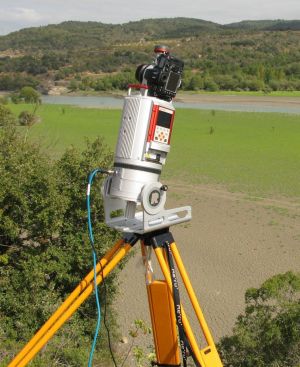Topography - Terrestrial Laser Scanner Riegl VZ-400
Jump to navigation
Jump to search
Parameter to be measured:
- surface topography
Method:
- terrestrial laser scan
Equipment:
- Laser Scanner
- "internal" and external battery
- RiScan software
- Laptop, tripod, reflectors (not included)
Advantages:
- low power consumption: "internal" + external battery can provide almost a day of scanning
- backup-batteries can be added and removed during operation
- runs on 12 V, car-battery (adaptor supplied) can be used
- extensive function menu accessible directly over scanner display
- very quick overview and fine scans
- eye-safe IR-laser
- flash-design reminding Star-Wars fans of R2D2
- optional tilt-mount enables stable non-vertical (up to horizontal) device positions
- Laser plummet for precise locating of device
- widely configurable automativ recognition of reflective targets in overview scan and subsequent fine scan
- built-in Wireless option
- high scanning speed, comparatively large range
- sophisticated camera calibration options
- recording of multiple echos along laser path
- cables attached to non-moving part of scanner - no danger of "strangling" during rotation
- integrated GPS receiver
- support reflective cylinders as targets
Disadvantages:
- bulky and heavy: transport in the original box as ordinary flight baggage not possible; carrying in the field is painful
- IR laser has poor reflectivity (shorter range) on moist surfaces and snow
- operation via device panel becomes fiddly e.g. when manually selecting non-detected reflectors
- PC-software RiScan is complicated and non-intuitive (combines scanner operation, georeferencing and basic analysis); also used for other scanner models, but VZ-400 still missing in some dialog boxes
- only selection of rectangular scan areas possible (opposed to polygons)
- designed for use with reflective targets - use of non-reflective targets is a hassle
- sounds during operation do not match those of R2D2
What to watch out for:
- minimum range ~ 2 m
- laser beam can partially penetrate PE target spheres
- when using reflective cylinders as targets, the cylinders are assumed to have their axis parallel to z-direction of the scanner. If you use tilted instrument positions, use a calibrated tilt mount to "rotate" the tilted position back to normal, so the cylinders are oriented correctly
Problems/Questions:
Price:
with Nikon DSLR and separate carrying case 104000 € (2010, Germany)
Links
Projects that used the above equipment:
Other related web sites:
